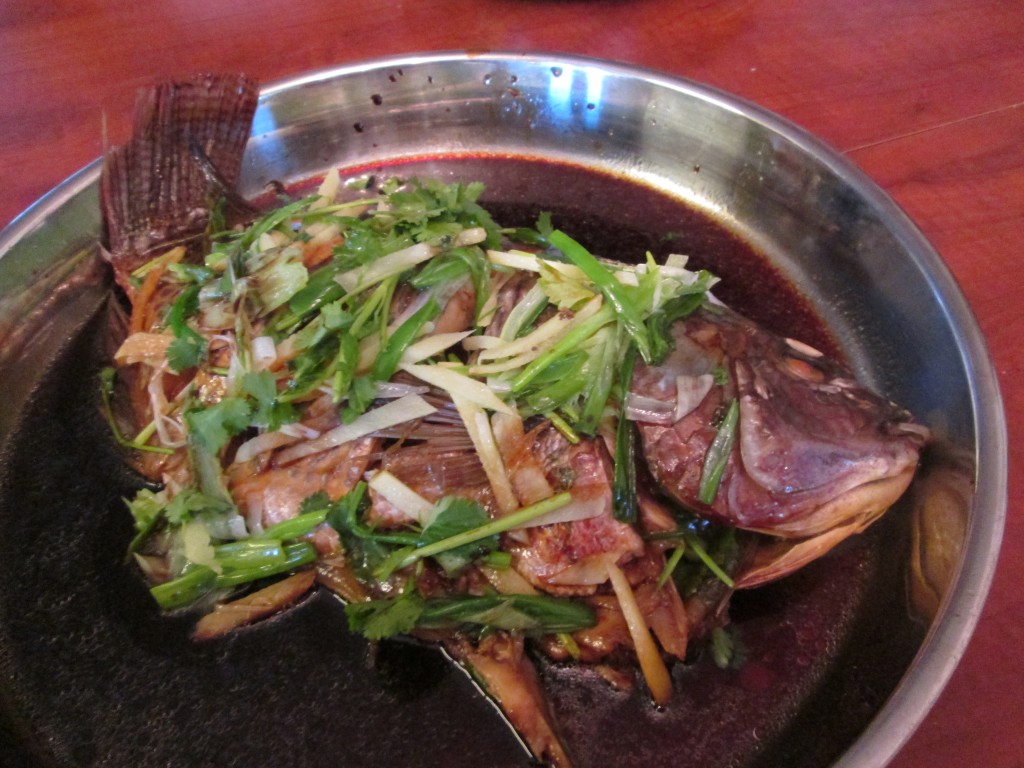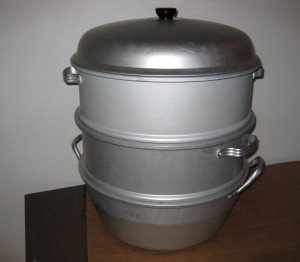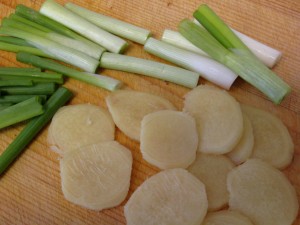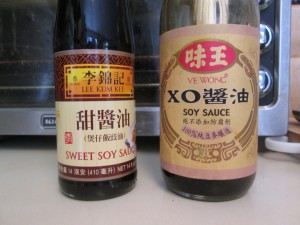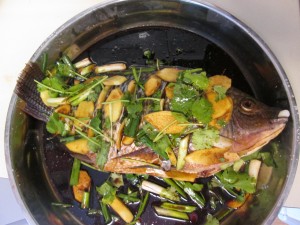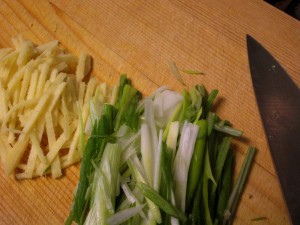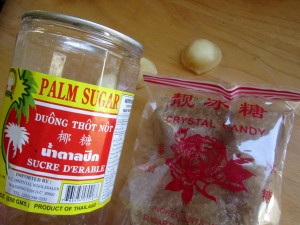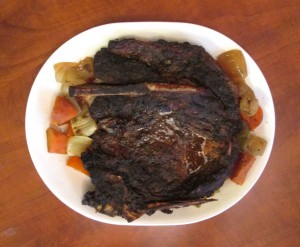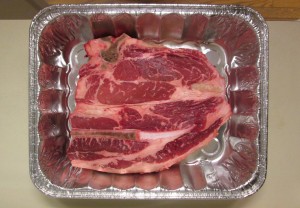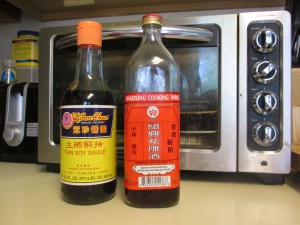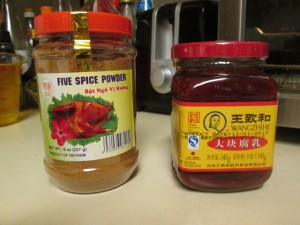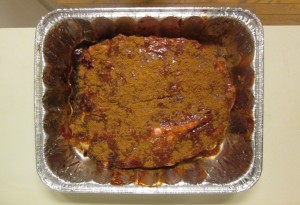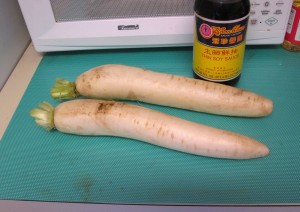(by Corbo Eng)
Steamed Tilapia
Generally, across cultures—most notably, in the West, steaming is not a very popular cooking method; but, it has a more pronounced role in Asia—even a central one in Chinese cuisine (particularly, in Cantonese cooking). Just think of all of the steamed items found in a typical dim sum brunch: the steamed shrimp dumplings (har gow), the steamed pork buns (char siu bao), the steamed rice crêpes (cheung fun), and even dessert in the form of steamed yellow sponge cake (ma lai go). These steamed items complement the normally varied array of fried dim sum items and help to create a more balanced, less monotonous overall experience as diners eat and move on from plate to plate.
Of course, the benefit of steaming foods isn’t necessarily to serve as a contrast to frying foods in the larger context of a meal—such as a dim sum brunch. The method has its own inherent benefits. When foods are steamed, they don’t lose much, if any, moisture. Steaming, additionally, brings out the natural flavors of foods because steaming is, in and of itself, such a “neutral” process. No cooking oil is used; and, whatever flavorings are employed are usually quite simple and aren’t too bold or prominent—in order to showcase the natural flavors. Ultimately, the end result soars or crashes on the freshness of what’s being steamed.
When foods are fresh, one is motivated to enhance that freshness and rely on it. This is very much the case with fish—a food that becomes notoriously less appealing once it isn’t fresh anymore—and whose delicate nature can be easily overwhelmed by other cooking methods that might dry it out or cover it up. In fact, there is a prevailing sentiment amongst Cantonese chefs that pan frying or deep frying a fish, for example, is only acceptable if it is no longer fresh and is past its prime. These methods, in that instance, are seen as a favorable way to mask the deteriorating quality. Otherwise, in their view, fish is best steamed. No Cantonese home cook, sharing what is a very pervasive attitude and a cultural predisposition to reveal fresh flavors, is likely to argue with that thinking.
Cooking Equipment
1 large Chinese style steamer pot (or a large wok with rack adapted for steaming)
2 stainless steel pans (or something equivalent) about 12 inches in diameter
Preparation Time
20 – 30 minutes to prepare ingredients
15 – 20 minutes to steam fish
3 – 5 minutes of post-steaming prep
Ingredients (for steaming)
1 tilapia (about 1 ½ lbs.) (serves two)
2 ½ inch knob of ginger (or about 4.5 oz. of ginger – sliced into coins)
4 whole stalks of scallions (2 left whole with the rest cut up into 1 in. segments)
7 sprigs of cilantro (from a bunch)
3 tablespoons of Shaoxing rice wine
3 tablespoons of soy sauce (XO soy sauce highly recommended)
2 ½ tablespoons of sweet soy sauce
kosher salt
white pepper
Ingredients (for post-steaming)
2 lumps of palm sugar (or rock sugar) to yield 2 tablespoons
1 ½ inch knob of ginger (or about 1.5 oz. of ginger – sliced into coins)
2 whole stalks of scallions (cut into 1 in. segments and julienned)
3 sprig of cilantro (to be used as garnish)
3 tablespoons of Shaoxing rice wine
3 tablespoons of soy sauce (XO soy sauce highly recommended)
2 ½ tablespoons of sweet soy sauce
7 tablespoons of cooking oil (preferably peanut oil)
Directions
Pre-Steaming
1) Start by filling the steamer pot with water so that the water reaches about a ¼ of the way up. Cover the pot, turn the burner on high, and begin heating the water.
2) While the water is heating up, prepare the ginger by first breaking off (either manually or with a knife) any protrusions or bumps from the surface. The goal is to have a generally unobstructed surface all around the knob of ginger. Then, using the dull edge of a paring knife or the edge of a metal spoon, scrape the outer skin away until the flesh is revealed.
3) Place the peeled knob on a cutting board and, using a sharp knife, cut the ginger into slices (making sure that each slice is cut thinly) so that the resulting slices resemble coins. Complete until the entire knob of ginger has been cut and, then, set aside.
4) Next, on a cutting board, with the side of a cleaver or meat tenderizer, whack 2 stalks of scallions gently—with just enough force to slightly bruise and flatten them. Set aside. Then, with the remaining 2 stalks lined next to each other, slice off the root ends and discard. Cut the stalks by slicing off segments about 1 inch in length. Set these aside.
5) Now, rinse the fish under cold running water to remove any blood or loose scales. Pat the fish dry with a paper towel. Place it on a cutting board and, with a sharp knife, cut a total of three slits (about 1 inch to 1 ½ inch apart) into the flesh on both sides. Each slit should be roughly diagonal in direction and be cut to the spine (without actually cutting through it).
6) Hold the fish over one of the steaming pans; season both sides liberally with salt. Sprinkle one side with white pepper. Gently pull open the fish’s abdominal cavity and salt the inside. Fill the cavity with a 3 or 4 coins of ginger, a few scallion segments, and about 3 sprigs of cilantro (enough to occupy but not stuff the space). Make a “bed” for the fish to rest on by using 4 to 6 coins of ginger (depending on the length of the fish) and the two flattened scallion stalks that have been left whole.
7) Splash the inner cavity with some rice wine, XO soy sauce, and sweet soy sauce (leaving some for the exterior body). Make sure the liquids are evenly distributed over the main body of the fish as well as its edges so that some of it “bleeds” over and seeps underneath to the other side.
8) Place the remaining coins of ginger and scallion segments on the fish to cover its surface. Take one or two slices of the ginger and jam them into each of the slits that were previously cut. The slices should fit snuggly, snap in place, and stand upright. Spread the remaining sprigs of cilantro over the fish.
9) Once the water has begun to boil and a steady, rising steam is achieved, place the pan with the fish into the steamer pot, cover, and steam for about 15 to 20 minutes. Check after 15 minutes for doneness by taking a paring knife or fork to see if the flesh flakes off the bone (at the thickest part of the body, preferably, at the slit). Continue steaming if the flesh still clings to the bone or is pink.
During and Post-Steaming
10) While the fish is steaming, prepare the second stash of ginger and scallions. First, slice the ginger thinly into coins as before. Once finished, stack the slices—three or four at a time (depending on thickness)—and julienne the ginger. The end result should be a neat pile of match stick slices. Cut the scallion stalks into 1 inch segments. Once completed, further cut the segments into julienned strips. This is best done by halving each cylindrical segment so that a flat surface is formed. The flat part can, then, be placed down onto the cutting board to make the julienning easier (without the segments rolling about). Set the julienned ginger and scallions aside.
11) Prepare the final sauce by combining the second portions of Shaoxing wine, XO soy sauce, and sweet soy sauce into a sauce pan. On a cutting board, break the rock sugar (or palm sugar) into smaller pieces by striking it with a meat tenderizing mallet or the side of a cleaver. Placing a dish towel or paper towel over the lumps of sugar when striking them should prevent the broken pieces from shooting off haphazardly. Collect 2 tablespoons of the sugar, once smashed, and drop them into the sauce pan. Heat on low, stirring occasionally, until the sugar melts into the liquids. Ensure that the sauce is modestly hot—but not boiling. In a separate sauce pan, heat the oil (up to a point where there is a hint of smoke) and leave it on the burner.
12) When the fish is ready, lift the steaming pan from the steamer pot and transfer the fish to a second, clean pan. Remove all of the spent slices of ginger, scallions, and cilantro (on the exterior body, inside the abdominal cavity, and underneath the fish). At this point, the herbs and liquid will have acquired a fishy taste and should be discarded. Once the fish has been transferred, pour the sauce over the fish to evenly cover it. Spill some around the sides and edges of the fish as well.
13) Drop the julienned ginger and scallions into the sauce pan of hot oil. Allow the ginger and scallions to sizzle and brighten. If necessary, mix gently to allow all pieces to come in contact with the oil. Then, using a slotted spoon or tongs, remove the ginger and scallions from the oil (allowing the oil to cling). Spread them evenly over the fish. Garnish with remaining cilantro. Serve with white rice, and eat immediately.
Cantonese Pot Roast
Classic pot roast is one of my favorite comfort foods—a dish that I’ve made for my family and myself countless times. It’s a rather straightforward dish of meat and vegetables that never fails to deliver. However, over time, I needed to alter my original recipe in order to keep it fresh and interesting. To change up, I’d shelve the pot roast for an outing of Chinese roast pork (char sui), like the kind served at Cantonese restaurants—but made with a fatty picnic butt rather than pork loin. The two—pot roast and roast pork—seemed to complement each other well in terms of how they offered different flavor profiles with the former accentuating its herbs and the latter its savory sweetness in a great interplay that belied the fact that I had made them a week apart on separate Wednesdays, for example, as part of protein-heavy midweek indulgences.
I guess, it was just a matter of time that the two dishes, which I would prepare in the same kind of pans and roast in the same way, would end up blending in my mind. I like to add Chinese elements to non-Chinese dishes anyway—not necessarily as an effort to experiment (although there is that in spirit)—but to bring all of my culinary influences to bear on a dish. So, in my mind’s eye, a pot roast could easily have a Chinese permutation and take on Chinese characteristics—not only that of char sui, which is made with hoisin sauce (a popular Chinese glaze or barbecue sauce) but also Chinese style beef (brisket) stew, which features Chinese white radish and Chinese five spice powder.
However, minus the ubiquitous red food coloring associated with char sui, my Cantonese pot roast isn’t an unsightly neon red. Instead, it exudes a rich, blackened finish from the dark soy sauce and hoisin sauce. Additionally, by using blade roast, a cut of beef with a bone intact but that isn’t as thick or dense as other cuts, the effect of the marinade is maximized. In the end, cooked slowly at a low temperature, the final product is a flavorful, ultra-tender pot roast that is highlighted by distinctive notes of fermented red bean curd (an overlooked, perhaps, secretive char sui ingredient)…all of which is rounded out and embellished by the aromatic kiss of the five spice powder.
Ingredients
2 ½ to 3 lbs. blade roast (serves two)
2 large carrots (about 8 oz.)
1 medium Chinese white radish (about 8 oz.)
2 stalks of celery (about 5 oz.)
2 teaspoons of salt (preferably kosher salt)
freshly milled black pepper
1 tablespoon of light soy sauce
2 tablespoons of Shaoxing rice wine
3 tablespoons of hoisin sauce
3 tablespoons of (or 3 cubes) red fermented bean curd
1 tablespoon of honey (preferably from a squeeze bottle)
4 teaspoons of Chinese five spice powder
Preparation Time
15 – 20 minutes to season and marinate the blade roast
6 hours (or overnight preferably) to marinate the meat
2 to 3 hours of baking (depending on oven)
Directions
(1) First, marinate the blade roast. Place it into a 13’’x 9’’x 2 ¾ ” aluminum baking pan (or an equivalent oven-safe vessel). Using tongs to flip, season both sides of the blade roast liberally with salt. Repeat the process, this time with freshly milled black pepper.
(2) Next, add the light soy sauce and Shaoxing rice wine. Use the convex side of a spoon to evenly spread out the liquids (especially, the soy sauce). Flipping it with the tongs, massage the liquids into the meat until they are well distributed and there is an even color and appearance on both sides.
(3) Then, add the hoisin sauce and incorporate it into the meat with the convex side of a spoon (as described above) until the sauce is thinned out and slathered evenly onto the surface on both sides. Flip the meat as necessary to get an even and uniform distribution.
(4) After the hoisin sauce has been applied, add the cubes of red fermented bean curd. Mash down the cubes using the spoon. It will crush easily and yield pasty bits and chunks. Knead these into the meat with the convex end of the spoon. Flip the meat with the tongs to treat the other side. Use the edge of the spoon to scrape some of the pasty film from the first side and spread it evenly onto the other side so that the entire piece of meat is coated. At this point, the blade roast should have a uniformly pasty appearance with a dark-red color.
(5) Finally, add the honey. It is okay if the honey is spread on only one side. Next, making sure that no area is untreated, sprinkle each side of the blade roast with the Chinese five spice powder (using two teaspoons of powder per side). It is not necessary to knead the powder into the meat as was done with the soy sauces, hoisin sauce, and cubes of bean curd. Rather, in the end, the blade roast should be evenly dusted with the powder, which will dissolve and season the meat during the time in the oven.
(6) Cover the aluminum pan snugly with foil, making sure that there is a tight fit, so that there are no gaps, holes, or openings where steam can escape. Set the pan aside in the refrigerator to marinate overnight (or for, at least, 6 hours).
(7) When ready to cook the blade roast, pre-heat the oven to 350 degrees. Once the temperature has been firmly established, lower it to 200 degrees and place the aluminum pan (tightly wrapped in foil as described in the previous step) into the oven and bake for one hour.
(8) While the blade roast is in the oven, prepare the carrots and Chinese white radish for cutting by, first, scraping the exterior to remove the outermost skin. The dull, non-cutting edge of a paring knife knife serves this purpose nicely (or use a potato peeler). Cut the carrots roughly into irregular chunks. Remove the stem of the white radish and halve it to start. Then, continue by cutting each subsequent section into halves until the pieces approximate the size of the chunked carrots. Cut the celery stalks as well in the same rough style to approximate the size of the other two. Keep in mind that the objective is to have the vegetables cook and be consumed alongside the meat when served. So, do not cut the vegetables into pieces that are too small (as with mirepoix) so that they begin to dissolve or lose too much body during cooking. Set the cut-up vegetables aside.
(9) After one hour, take the blade roast out of the oven and carefully peel back the aluminum foil (taking care not to rip it or poke any holes in it). Lift the meat out of the pan and place it temporarily onto a plate. Next, spread the bottom of the pan with the cut-up vegetables to ensure an even base and distribution of pieces. Make sure to coat the pieces with the juices from the meat. Season the vegetables with salt (optional).
(10) Using the tongs, return the blade roast to the pan by placing it on top of the vegetables. Cover the pan back up with the aluminum foil (as before) and bake at 200 degrees for an additional hour. After the second hour, uncover the pan and poke the meat with a fork to test for doneness. If the fork penetrates the meat effortlessly, it is ready to be served. If not, bake for an additional half hour at the same setting until tender. Serve the pot roast with white rice.
Copyright 2014 (Corbo Eng). All rights reserved.
All photos by Corbo Eng.

